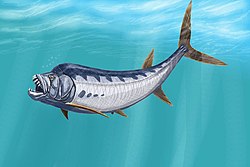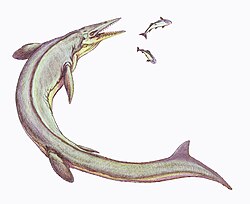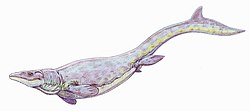Fish
Cartilaginous fish
| Cartilaginous fish of the Mooreville Chalk Formation | ||||||
|---|---|---|---|---|---|---|
| Genus | Species | Location | Stratigraphic position | Abundance | Notes | Images |
C. appendiculata [3] |   | |||||
C. mantelli [3] | ||||||
E. barberi [4] | ||||||
E. mirificus [4] | ||||||
I. williamsae [4] | ||||||
O. cuspidata | ||||||
P. hewletti [4] | ||||||
P. mammillaris [4] | ||||||
P. mortoni [3] | ||||||
P. polygyrus [4] | ||||||
P. affinis [4] | ||||||
P. laevis [3] | ||||||
S. serrata [3] | ||||||
S. rhaphiodon [4] | ||||||
S. texanus [3] | ||||||
S. falcatus [4] | ||||||
S. kaupi [3] | ||||||
Bony fish
| Bony fish of the Mooreville Chalk Formation | ||||||
|---|---|---|---|---|---|---|
| Genus | Species | Location | Stratigraphic position | Abundance | Notes | Images |
A. dunklei [4] | An albuliform |    | ||||
B. crieleyi [4] | ||||||
C. nepaholica [4] | An aulopiform | |||||
An aulopiform | ||||||
E. saevus [4] | ||||||
Hoplopteryx sp. [4] | ||||||
I. ctenodon [4] | ||||||
M. hardi [4] | ||||||
P. caninus [4] | ||||||
P. gladius [3] | ||||||
S. leanus [4] | ||||||
S. apicalis [4] | An aulopiform | |||||
X. audax [4] | ||||||











